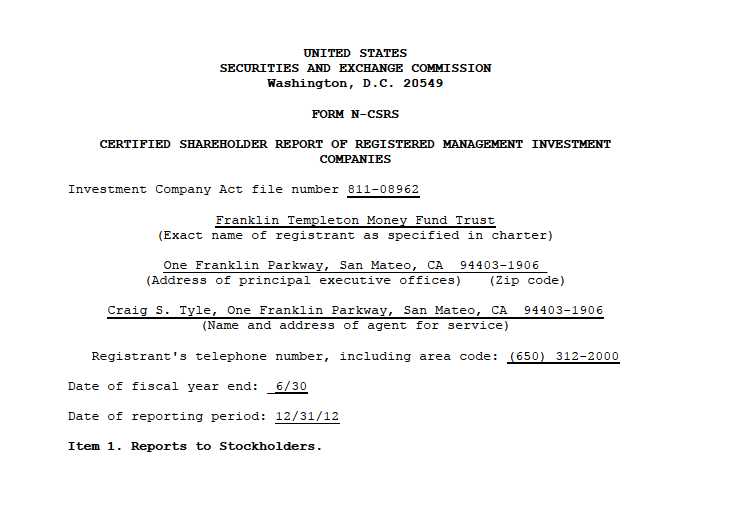
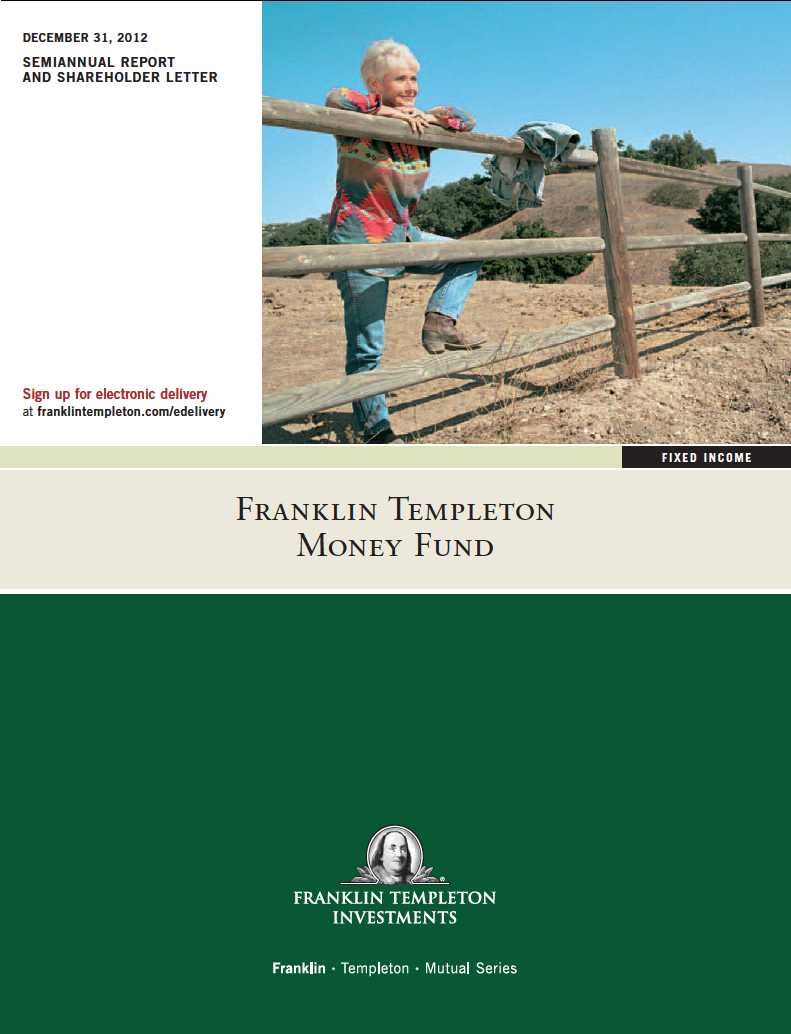

| 1
Semiannual Report
Franklin Templeton Money Fund
Your Fund’s Goal and Main Investments: Franklin Templeton Money Fund seeks to provide as high a level of current income as is consistent with preservation of shareholders’ capital and liquidity. The Fund invests through The Money Market Portfolio (the Portfolio) mainly in high-quality, short-term U.S. dollar denominated money market securities of domestic and foreign issuers. The Fund attempts to maintain a stable $1.00 share price.
Performance data represent past performance, which does not guarantee future results. Investment return will fluctuate. Current performance may differ from figures shown. Please visit franklintempleton.com or call (800) 342-5236 for most recent month-end performance.
An investment in the Fund is not insured or guaranteed by the Federal Deposit Insurance Corporation or any other government agency or institution. Although the Fund seeks to preserve the value of your investment at $1.00 per share, it is possible to lose money by investing in the Fund.
This semiannual report for Franklin Templeton Money Fund covers the period ended December 31, 2012.
Performance Overview
In an effort to promote economic growth, the Federal Reserve Board (Fed) held short-term interest rates at a historically low level during the six-month period under review. As a result, the Fund’s Class A shares’ seven-day effective yield remained unchanged at 0.00% from June 30, 2012, through December 31, 2012. The Fund’s Class B, C and R shares’ performance was the same, as shown in the Performance Summary on page 6.
Economic and Market Overview
During the six months under review, U.S. economic data remained mixed. Manufacturing indicators strengthened slightly and the housing sector remained resilient with new and existing home sales as well as prices pointing toward a gradual strengthening trend, albeit from a low base. Consumer spending generally increased and consumer confidence reached its highest level during the period in November. However, oil prices rose and gross domestic product growth was moderate.
In September, the Fed acknowledged the need for further policy accommodation and announced a third round of quantitative easing (QE3). QE3 consisted of additional $40 billion monthly purchases of mortgage-backed securities until the labor market improves. The Fed also continued buying long-term Treasuries and selling short-term Treasuries in an effort to put downward pressure on long-term interest rates. In December, the Fed announced a 6.5% unemployment
The dollar value, number of shares or principal amount, and names of all portfolio holdings are listed in the Fund’s Statement of Investments (SOI). The SOI begins on page 13.
Semiannual Report | 3
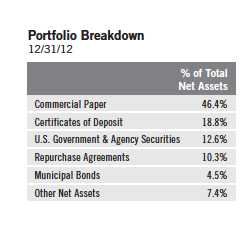
target as a guide to maintaining the historically low federal funds target rate. Economists, business leaders and market watchers were concerned about the U.S. “fiscal cliff” when, unless Congress acted, automatic income tax increases and federal budget cuts were scheduled to take effect in 2013. They feared these events could cause another U.S. recession. Not knowing whether Congress and the President would avert these measures after the U.S. election, many businesses delayed major investment and hiring decisions. Lawmakers reached a late compromise on January 1, 2013, a day after the reporting period ended. The approved legislation will maintain some tax cuts for most Americans but increase rates on the wealthiest. It will also delay the automatic federal spending cuts scheduled to start in January 2013.
As investors gained confidence in the financial markets, the 10-year U.S. Treasury yield rose to 1.78% at year-end from 1.67% on June 30, 2012. During the six months under review, below-investment-grade corporate bonds, as measured by the Credit Suisse High Yield Index, produced strong returns and outperformed investment-grade fixed income markets, as measured by the Barclays U.S. Aggregate Index.
Investment Strategy
Consistent with our strategy, we invest, through the Portfolio, mainly in high-quality, short-term U.S. dollar denominated money market securities of domestic and foreign issuers, including bank obligations, commercial paper, repurchase agreements and U.S. government securities. We maintain a dollar-weighted average portfolio maturity of 60 days or less and a dollar-weighted average life of 120 days or less. We seek to provide shareholders with a high-quality, conservative investment vehicle; thus, we do not invest the Fund’s cash in derivatives or other relatively volatile securities that we believe involve undue risk.
4 | Semiannual Report
Manager’s Discussion
The six months under review were characterized by extremely low short-term interest rates, which pressured money market yields. We continued to invest the Portfolio’s assets in high-quality money market securities. On December 31, 2012, for example, 100% of the securities purchased for the Portfolio carried short-term credit ratings of A-1 or P-1, or higher, by independent credit rating agency Standard & Poor’s or Moody’s Investors Service.1
We appreciate your support, welcome new shareholders and look forward to serving your investment needs in the years ahead.
The foregoing information reflects our analysis, opinions and portfolio holdings as of December 31, 2012, the end of the reporting period. The way we implement our main investment strategies and the resulting portfolio holdings may change depending on factors such as market and economic conditions. These opinions may not be relied upon as investment advice or an offer for a particular security. The information is not a complete analysis of every aspect of any market, country, industry, security or the Fund. Statements of fact are from sources considered reliable, but the investment manager makes no representation or warranty as to their completeness or accuracy. Although historical performance is no guarantee of future results, these insights may help you understand our investment management philosophy.
1. These do not indicate ratings of the Fund.
Semiannual Report | 5
Performance Summary as of 12/31/12
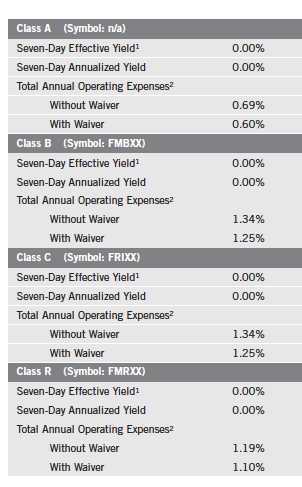
The investment manager of the Money Market Portfolio and administrator have contractually agreed to waive or assume certain expenses so that common expenses (excluding Rule 12b-1 fees) for each class of the Fund do not exceed 0.60% (other than certain nonroutine expenses) until 10/31/13. In efforts to prevent a negative yield, the investment manager, Fund administrator and Fund distributor have voluntarily agreed to waive or limit their respective fees, assume as their own expense certain expenses otherwise payable by the Fund, and if necessary, make a capital infusion into the Fund. These waivers, expense reimbursements and capital infusions, which are not reflected in the table above, are voluntary and may be modified or discontinued by the investment manager, Fund administrator or Fund distributor at any time, and without further notice. There is no guarantee the Fund will be able to avoid a negative yield.
1. The seven-day effective yield assumes compounding of daily dividends, if any.
2. Figures are as stated in the Fund’s prospectus current as of the date of this report. In periods of market volatility, assets may decline significantly, causing total annual Fund operating expenses to become higher than the figures shown.
Annualized and effective yields are for the seven-day period ended 12/31/12. The Fund’s average weighted life and average weighted maturity were each 29 days. Yield reflects Fund expenses and fluctuations in interest rates on Portfolio investments.
Performance data represent past performance, which does not guarantee future results. Investment return will fluctuate. Current performance may differ from figures shown. Please go to franklintempleton.com or call (800) 342-5236 for most recent month-end performance.
6 | Semiannual Report
Your Fund’s Expenses
Franklin Templeton Money Fund
As a Fund shareholder, you can incur two types of costs:
- Transaction costs, including sales charges (loads) on Fund purchases; and
- Ongoing Fund costs, including management fees, distribution and service (12b-1) fees, and other Fund expenses. All mutual funds have ongoing costs, sometimes referred to as operating expenses.
The following table shows ongoing costs of investing in the Fund and can help you understand these costs and compare them with those of other mutual funds. The table assumes a $1,000 investment held for the six months indicated.
Actual Fund Expenses
The first line (Actual) for each share class listed in the table provides actual account values and expenses. The “Ending Account Value” is derived from the Fund’s actual return, which includes the effect of Fund expenses.
You can estimate the expenses you paid during the period by following these steps. Of course, your account value and expenses will differ from those in this illustration:
| 1. | Divide your account value by $1,000. |
| If an account had an $8,600 value, then $8,600 ÷ $1,000 = 8.6. | |
| 2. | Multiply the result by the number under the heading “Expenses Paid During Period.” |
| If Expenses Paid During Period were $7.50, then 8.6 x $7.50 = $64.50. |
In this illustration, the estimated expenses paid this period are $64.50.
Hypothetical Example for Comparison with Other Funds
Information in the second line (Hypothetical) for each class in the table can help you compare ongoing costs of investing in the Fund with those of other mutual funds. This information may not be used to estimate the actual ending account balance or expenses you paid during the period. The hypothetical “Ending Account Value” is based on the actual expense ratio for each class and an assumed 5% annual rate of return before expenses, which does not represent the Fund’s actual return. The figure under the heading “Expenses Paid During Period” shows the hypothetical expenses your account would have incurred under this scenario. You can compare this figure with the 5% hypothetical examples that appear in shareholder reports of other funds.
Semiannual Report | 7
Your Fund’s Expenses (continued)
Please note that expenses shown in the table are meant to highlight ongoing costs and do not reflect any transaction costs, such as sales charges. Therefore, the second line for each class is useful in comparing ongoing costs only, and will not help you compare total costs of owning different funds. In addition, if transaction costs were included, your total costs would have been higher. Please refer to the Fund prospectus for additional information on operating expenses.
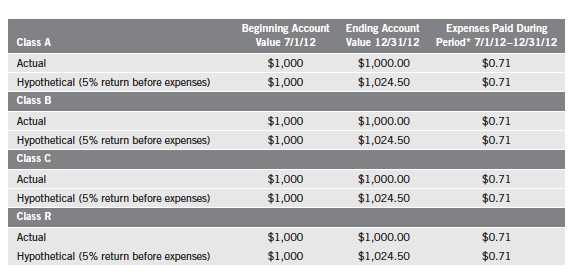
*Expenses are calculated using the most recent six-month expense ratio, net of voluntary and contractual expense waivers, annualized for each class (A: 0.14%; B: 0.14%; C: 0.14%; and R: 0.14%), which includes the expenses incurred by the Portfolio, multiplied by the average account value over the period, multiplied by 184/365 to reflect the one-half year period.
8 | Semiannual Report
Franklin Templeton Money Fund Trust
Financial Highlights
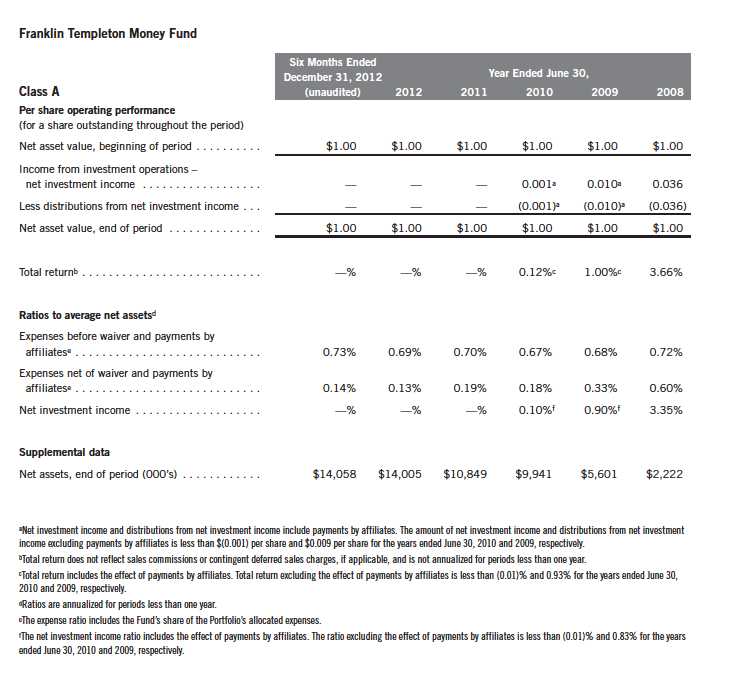
Semiannual Report | The accompanying notes are an integral part of these financial statements. | 9
Franklin Templeton Money Fund Trust
Financial Highlights (continued)

10 | The accompanying notes are an integral part of these financial statements. | Semiannual Report
Franklin Templeton Money Fund Trust
Financial Highlights (continued)

Semiannual Report | The accompanying notes are an integral part of these financial statements. | 11
Franklin Templeton Money Fund Trust
Financial Highlights (continued)

12 | The accompanying notes are an integral part of these financial statements. | Semiannual Report
Franklin Templeton Money Fund Trust
Statement of Investments, December 31, 2012 (unaudited)

Semiannual Report | The accompanying notes are an integral part of these financial statements. | 13
Franklin Templeton Money Fund Trust
Financial Statements
Statement of Assets and Liabilities
December 31, 2012 (unaudited)
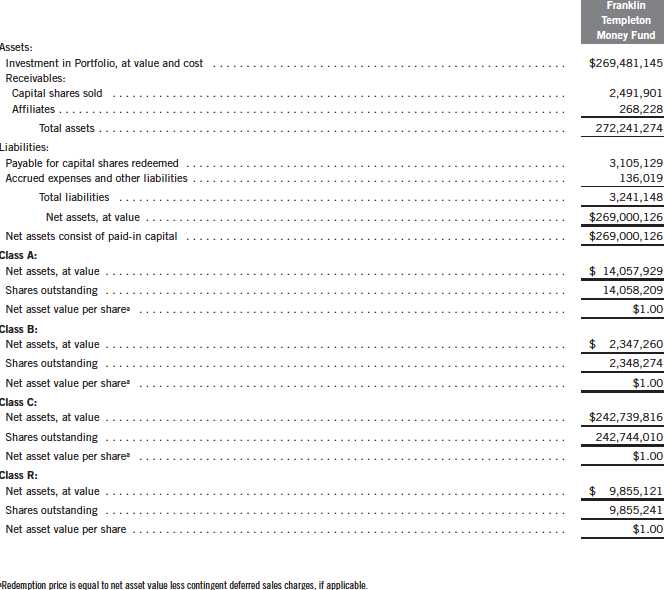
14 | The accompanying notes are an integral part of these financial statements. | Semiannual Report

Semiannual Report | The accompanying notes are an integral part of these financial statements. | 15
Franklin Templeton Money Fund Trust
Financial Statements (continued)

16 | The accompanying notes are an integral part of these financial statements. | Semiannual Report
Franklin Templeton Money Fund Trust
Notes to Financial Statements (unaudited)
Franklin Templeton Money Fund
1. ORGANIZATION AND SIGNIFICANT ACCOUNTING POLICIES
Franklin Templeton Money Fund Trust (Trust) is registered under the Investment Company Act of 1940, as amended, (1940 Act) as an open-end investment company, consisting of one fund, the Franklin Templeton Money Fund (Fund). The Fund offers four classes of shares: Class A, Class B, Class C, and Class R. Effective March 1, 2005, the Fund no longer offered Class B shares for purchase. As disclosed in the fund prospectus, Class B shares convert to Class A shares after eight years of investment; therefore, all Class B shares will convert to Class A by March 2013. Each class of shares differs by its initial sales load, contingent deferred sales charges, distribution fees, voting rights on matters affecting a single class and its exchange privilege.
The Fund invests substantially all of its assets in The Money Market Portfolio (Portfolio), which is registered under the 1940 Act as an open-end investment company. The accounting policies of the Portfolio, including the Portfolio’s security valuation policies, will directly affect the recorded value of the Fund’s investment in the Portfolio. The financial statements of the Portfolio, including the Statement of Investments, are included elsewhere in this report and should be read in conjunction with the Fund’s financial statements.
The following summarizes the Fund’s significant accounting policies.
a. Financial Instrument Valuation
The Fund holds Portfolio shares that are valued at the closing net asset value of the Portfolio. Under procedures approved by the Fund’s Board of Trustees (the Board), the Fund’s administrator, investment manager and other affiliates have formed the Valuation and Liquidity Oversight Committee (VLOC). The VLOC provides administration and oversight of the Fund’s valuation policies and procedures, which are approved annually by the Board. At December 31, 2012, the Fund owned 1.45% of the Portfolio.
b. Income Taxes
It is the Fund’s policy to qualify as a regulated investment company under the Internal Revenue Code. The Fund intends to distribute to shareholders substantially all of its taxable income and net realized gains to relieve it from federal income and excise taxes. As a result, no provision for U.S. federal income taxes is required.
The Fund recognizes the tax benefits of uncertain tax positions only when the position is “more likely than not” to be sustained upon examination by the tax authorities based on the technical merits of the tax position. As of December 31, 2012, and for all open tax years, the Fund has determined that no liability for unrecognized tax benefits is required in the Fund’s financial statements related to uncertain tax positions taken on a tax return (or expected to be taken on future tax returns). Open tax years are those that remain subject to examination and are based on each tax jurisdiction statute of limitation.
Semiannual Report | 17
Franklin Templeton Money Fund Trust
Notes to Financial Statements (unaudited) (continued)
Franklin Templeton Money Fund
| 1. | ORGANIZATION AND SIGNIFICANT ACCOUNTING POLICIES (continued) |
| c. | Security Transactions, Investment Income, Expenses and Distributions |
Security transactions are accounted for on trade date. Realized gains and losses on security transactions are determined on a specific identification basis. Income received from the Portfolio and estimated expenses are accrued daily. Dividends from net investment income are normally declared and distributed daily; these dividends may be reinvested or paid monthly to shareholders. Distributions to shareholders are determined according to income tax regulations (tax basis). Distributable earnings determined on a tax basis may differ from earnings recorded in accordance with accounting principles generally accepted in the United States of America. These differences may be permanent or temporary. Permanent differences are reclassified among capital accounts to reflect their tax character. These reclassifications have no impact on net assets or the results of operations. Temporary differences are not reclassified, as they may reverse in subsequent periods.
Net investment income, not including class specific expenses, is allocated daily to each class of shares based upon the relative value of the settled shares of each class. Realized and unrealized gains and losses are allocated daily to each class of shares based upon the relative proportion of net assets of each class. Differences in per share distributions, by class, are generally due to differences in class specific expenses.
d. Accounting Estimates
The preparation of financial statements in accordance with accounting principles generally accepted in the United States of America requires management to make estimates and assumptions that affect the reported amounts of assets and liabilities at the date of the financial statements and the amounts of income and expenses during the reporting period. Actual results could differ from those estimates.
e. Guarantees and Indemnifications
Under the Trust’s organizational documents, its officers and trustees are indemnified by the Trust against certain liabilities arising out of the performance of their duties to the Trust. Additionally, in the normal course of business, the Trust, on behalf of the Fund, enters into contracts with service providers that contain general indemnification clauses. The Trust’s maximum exposure under these arrangements is unknown as this would involve future claims that may be made against the Trust that have not yet occurred. Currently, the Trust expects the risk of loss to be remote.
18 | Semiannual Report
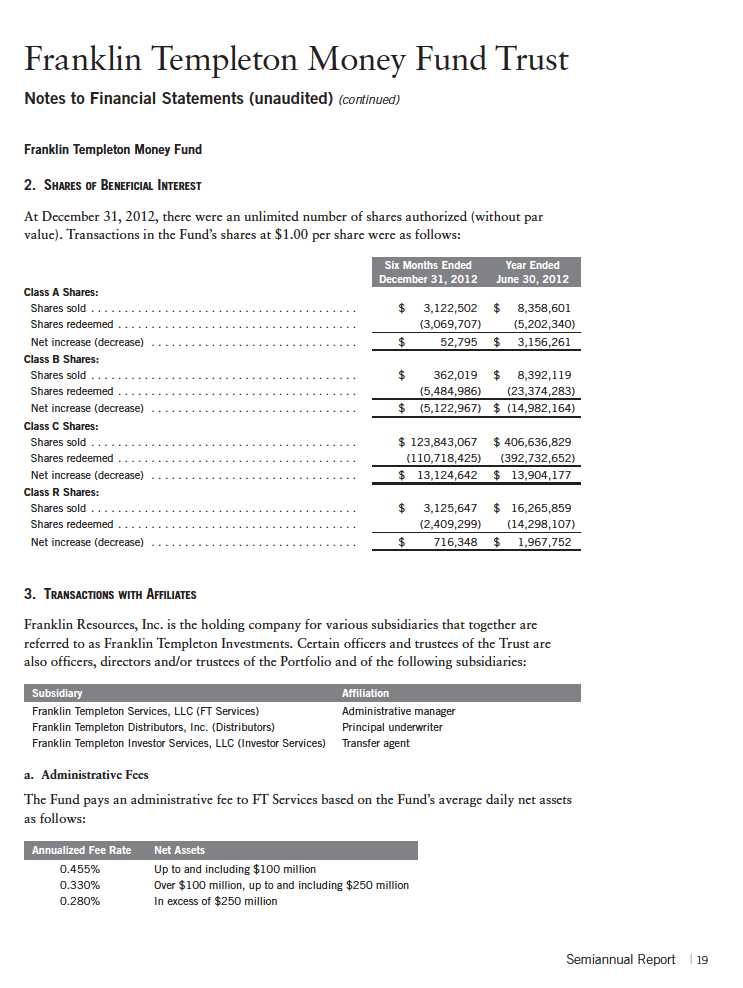
Franklin Templeton Money Fund Trust
Notes to Financial Statements (unaudited) (continued)
Franklin Templeton Money Fund
| 3. | TRANSACTIONS WITH AFFILIATES (continued) |
| b. | Distribution Fees |
The Board has adopted distribution plans for each share class, with the exception of Class A shares, pursuant to Rule 12b-1 under the 1940 Act. Distribution fees are not charged on shares held by affiliates. Under the Fund’s Class B, C, and R compensation distribution plans, the Fund pays Distributors for costs incurred in connection with the servicing, sale and distribution of the Fund’s shares up to the maximum annual plan rate for each class.
The maximum annual plan rates, based on the average daily net assets, for each class, are as follows:

c. Sales Charges/Underwriting Agreements
Front-end sales charges and contingent deferred sales charges (CDSC) do not represent expenses of the Fund. These charges are deducted from the proceeds of sales of Fund shares prior to investment or from redemption proceeds prior to remittance, as applicable. Distributors has advised the Fund of the following commission transactions related to the sales and redemptions of the Fund’s shares for the period:
CDSC retained
$15,165
d. Transfer Agent Fees
For the period ended December 31, 2012, the Fund paid transfer agent fees of $156,207, of which $63,335 was retained by Investor Services.
e. Waiver and Expense Reimbursements
FT Services has contractually agreed in advance to waive or limit its fees and to assume as its own expense certain expenses otherwise payable by the Fund so that the common expenses (i.e. a combination of management fees, administrative fees, transfer agent, and other expenses, but excluding distribution fees) for each class of the Fund do not exceed 0.60% (other than certain non-routine expenses or costs, including those relating to litigation, indemnification, reorganizations, and liquidations) until October 31, 2013.
In addition, in efforts to prevent a negative yield, FT Services, Investor Services, and Distributors have voluntarily agreed to waive or limit their respective fees, assume as their own expense certain expenses otherwise payable by the Fund and if necessary, make a capital infusion into the Fund such that no class returns a negative yield to its shareholders. This resulted in additional
20 | Semiannual Report
Franklin Templeton Money Fund Trust
Notes to Financial Statements (unaudited) (continued)
Franklin Templeton Money Fund
| 3. | TRANSACTIONS WITH AFFILIATES (continued) |
| e. | Waiver and Expense Reimbursements (continued) |
waivers and expense reimbursements of $1,329,800 for the period ended December 31, 2012. These waivers, expense reimbursements and capital infusions are voluntary and may be modified or discontinued by FT Services, Investor Services, or Distributors at any time, and without further notice. There is no guarantee that the Fund will be able to avoid a negative yield.
4. INCOME TAXES
At December 31, 2012, the cost of investments for book and income tax purposes was the same.
5. FAIR VALUE MEASUREMENTS
The Fund follows a fair value hierarchy that distinguishes between market data obtained from independent sources (observable inputs) and the Fund’s own market assumptions (unobservable inputs). These inputs are used in determining the value of the Fund’s financial instruments and are summarized in the following fair value hierarchy:
- Level 1 – quoted prices in active markets for identical financial instruments
- Level 2 – other significant observable inputs (including quoted prices for similar financial instruments, interest rates, prepayment speed, credit risk, etc.)
- Level 3 – significant unobservable inputs (including the Fund’s own assumptions in determining the fair value of financial instruments)
The inputs or methodology used for valuing financial instruments are not an indication of the risk associated with investing in those financial instruments.
For movements between the levels within the fair value hierarchy, the Fund has adopted a policy of recognizing the transfers as of the date of the underlying event which caused the movement.
At December 31, 2012, all of the Fund’s investments in financial instruments carried at fair value were valued using Level 1 inputs.
6. SUBSEQUENT EVENTS
The Fund has evaluated subsequent events through the issuance of the financial statements and determined that no events have occurred that require disclosure.
Semiannual Report | 21
The Money Market Portfolios
Financial Highlights
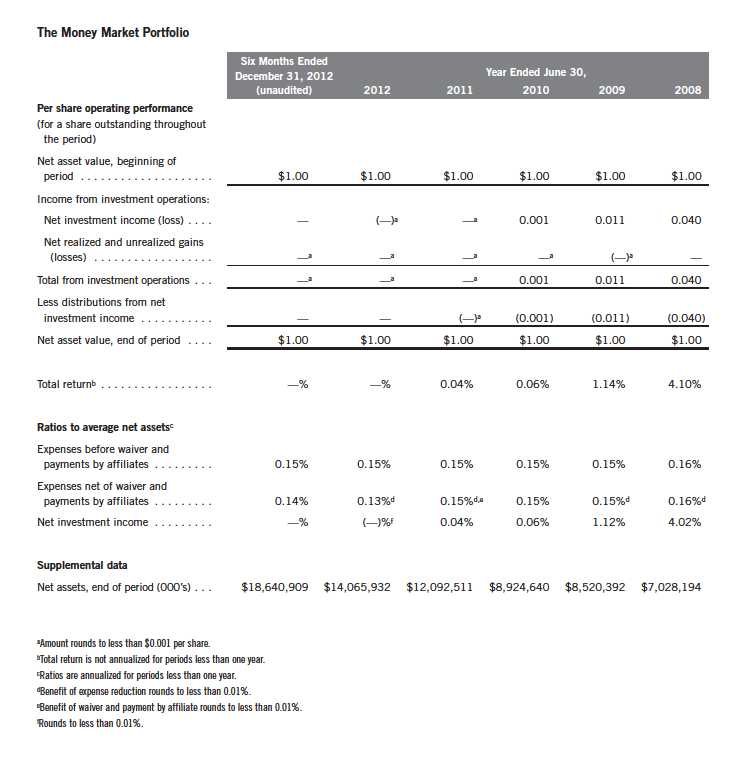
22 | The accompanying notes are an integral part of these financial statements. | Semiannual Report
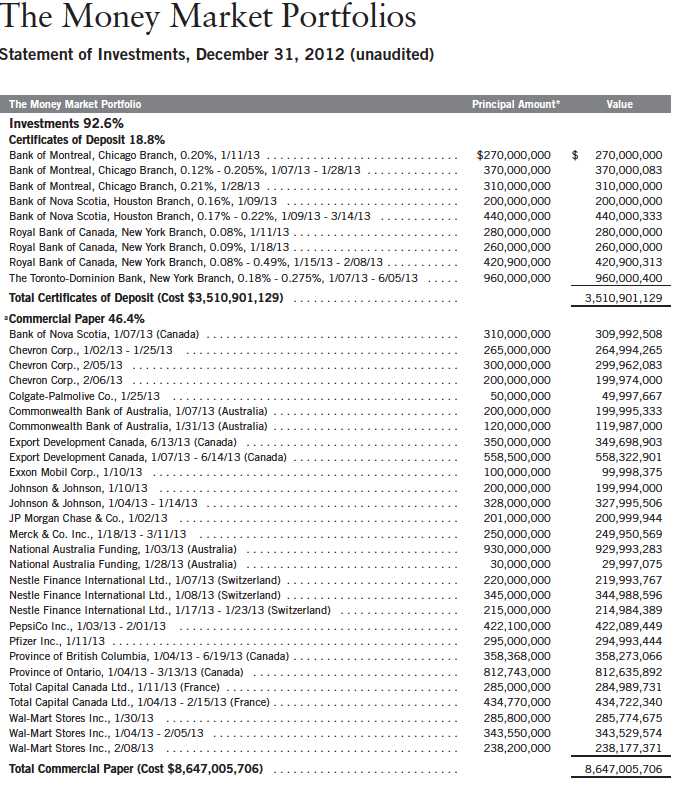
Semiannual Report | 23
The Money Market Portfolios
Statement of Investments, December 31, 2012 (unaudited) (continued)
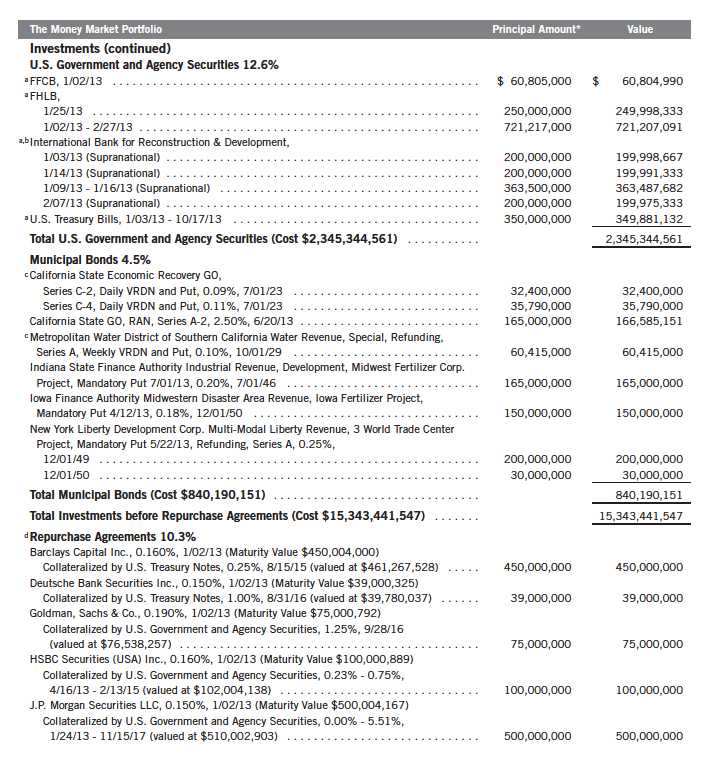
24 | Semiannual Report
The Money Market Portfolios
Statement of Investments, December 31, 2012 (unaudited) (continued)
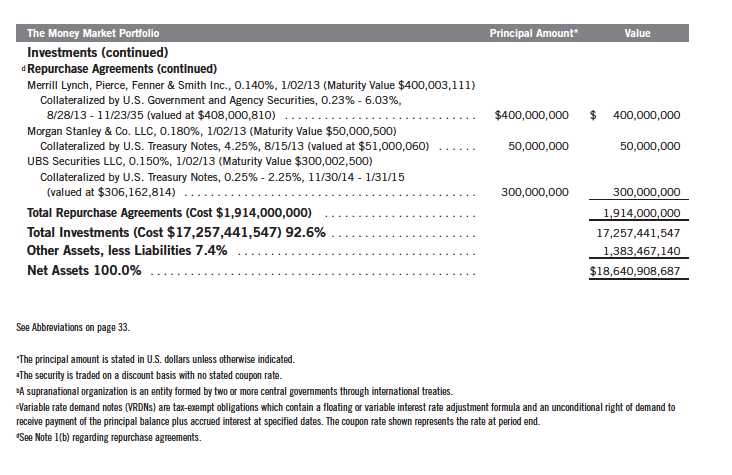
Semiannual Report | The accompanying notes are an integral part of these financial statements. | 25
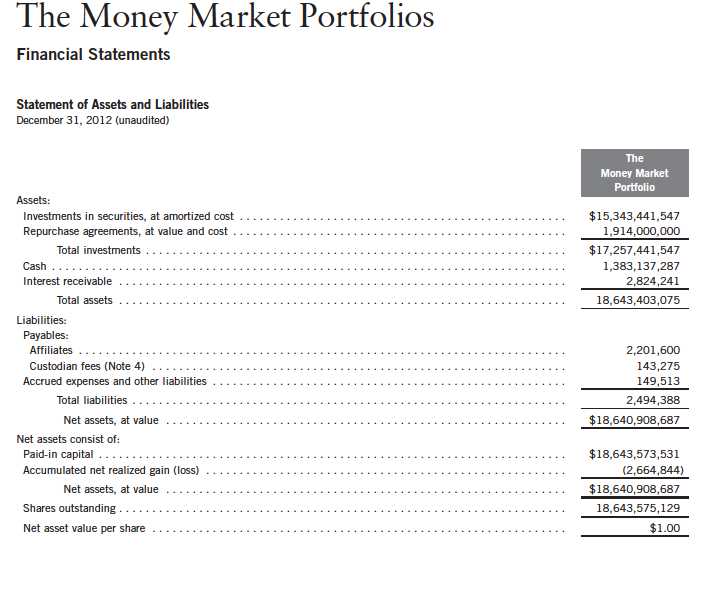
26 | The accompanying notes are an integral part of these financial statements. | Semiannual Report
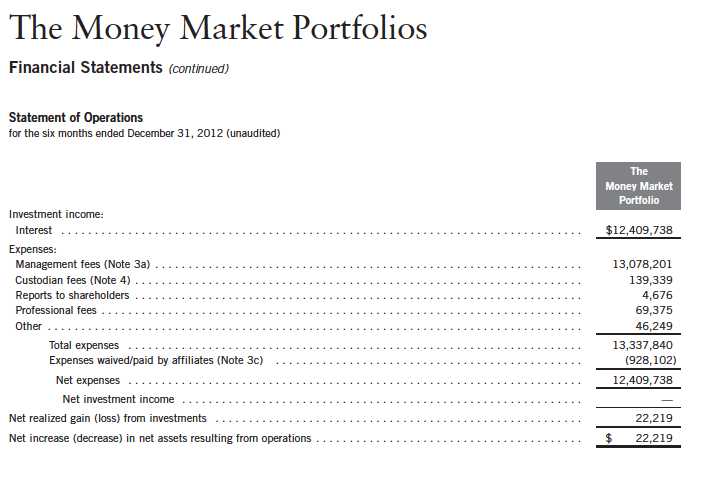
Semiannual Report | The accompanying notes are an integral part of these financial statements. | 27
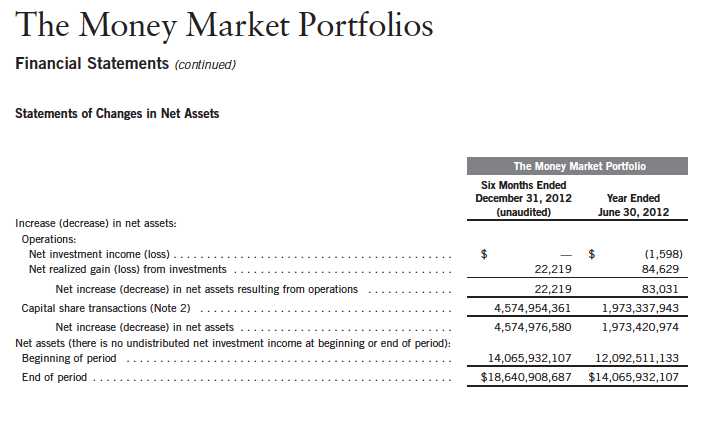
28 | The accompanying notes are an integral part of these financial statements. | Semiannual Report
The Money Market Portfolios
Notes to Financial Statements (unaudited)
The Money Market Portfolio
1. ORGANIZATION AND SIGNIFICANT ACCOUNTING POLICIES
The Money Market Portfolios (Trust) is registered under the Investment Company Act of 1940, as amended, (1940 Act) as an open-end investment company, consisting of one portfolio, The Money Market Portfolio (Portfolio). The shares of the Portfolio are issued in private placements and are exempt from registration under the Securities Act of 1933.
The following summarizes the Portfolio’s significant accounting policies.
a. Financial Instrument Valuation
Securities are valued at amortized cost, which approximates market value. Amortized cost is an income-based approach which involves valuing an instrument at its cost and thereafter assuming a constant amortization to maturity of any discount or premium. Under procedures approved by the Portfolio’s Board of Trustees (the Board), the Portfolio’s administrator, investment manager and other affiliates have formed the Valuation and Liquidity Oversight Committee (VLOC). The VLOC provides administration and oversight of the Portfolio’s valuation policies and procedures, which are approved annually by the Board.
b. Repurchase Agreements
The Portfolio enters into repurchase agreements, which are accounted for as a loan by the Portfolio to the seller, collateralized by securities which are delivered to the Portfolio’s custodian. The market value, including accrued interest, of the initial collateralization is required to be at least 102% of the dollar amount invested by the Portfolio, with the value of the underlying securities marked to market daily to maintain coverage of at least 100%. All repurchase agreements held by the Portfolio at period end had been entered into on December 31, 2012.
c. Income Taxes
It is the Portfolio’s policy to qualify as a regulated investment company under the Internal Revenue Code. The Portfolio intends to distribute to shareholders substantially all of its taxable income and net realized gains to relieve it from federal income and excise taxes. As a result, no provision for U.S. federal income taxes is required.
The Portfolio recognizes the tax benefits of uncertain tax positions only when the position is “more likely than not” to be sustained upon examination by the tax authorities based on the technical merits of the tax position. As of December 31, 2012 and for all open tax years, the Portfolio has determined that no liability for unrecognized tax benefits is required in the Portfolio’s financial statements related to uncertain tax positions taken on a tax return (or expected to be taken on future tax returns). Open tax years are those that remain subject to examination and are based on each tax jurisdiction statute of limitation.
Semiannual Report | 29
The Money Market Portfolios
Notes to Financial Statements (unaudited) (continued)
The Money Market Portfolio
| 1. | ORGANIZATION AND SIGNIFICANT ACCOUNTING POLICIES (continued) |
| d. | Security Transactions, Investment Income, Expenses and Distributions |
Security transactions are accounted for on trade date. Realized gains and losses on security transactions are determined on a specific identification basis. Interest income and estimated expenses are accrued daily. Amortization of premium and accretion of discount on debt securities are included in interest income. Dividends from net investment income are normally declared daily; these dividends may be reinvested or paid monthly to shareholders. Distributions to shareholders are determined according to income tax regulations (tax basis). Distributable earnings determined on a tax basis may differ from earnings recorded in accordance with accounting principles generally accepted in the United States of America. These differences may be permanent or temporary. Permanent differences are reclassified among capital accounts to reflect their tax character. These reclassifications have no impact on net assets or the results of operations. Temporary differences are not reclassified, as they may reverse in subsequent periods.
e. Accounting Estimates
The preparation of financial statements in accordance with accounting principles generally accepted in the United States of America requires management to make estimates and assumptions that affect the reported amounts of assets and liabilities at the date of the financial statements and the amounts of income and expenses during the reporting period. Actual results could differ from those estimates.
f. Guarantees and Indemnifications
Under the Trust’s organizational documents, its officers and trustees are indemnified by the Trust against certain liabilities arising out of the performance of their duties to the Trust. Additionally, in the normal course of business, the Trust, on behalf of the Portfolio, enters into contracts with service providers that contain general indemnification clauses. The Trust’s maximum exposure under these arrangements is unknown as this would involve future claims that may be made against the Trust that have not yet occurred. Currently, the Trust expects the risk of loss to be remote.
2. SHARES OF BENEFICIAL INTEREST
At December 31, 2012, there were an unlimited number of shares authorized (without par value). Transactions in the Portfolio’s shares at $1.00 per share were as follows:

30 | Semiannual Report
The Money Market Portfolios
Notes to Financial Statements (unaudited) (continued)
The Money Market Portfolio
3. TRANSACTIONS WITH AFFILIATES
Franklin Resources, Inc. is the holding company for various subsidiaries that together are referred to as Franklin Templeton Investments. Certain officers and trustees of the Trust are also officers, directors, and/or trustees of the Franklin Money Fund, the Franklin Templeton Money Fund Trust, the Institutional Fiduciary Trust, and of the following subsidiaries:
| Subsidiary | Affiliation |
| Franklin Advisers, Inc. (Advisers) | Investment manager |
| Franklin Templeton Investor Services, LLC (Investor Services) | Transfer agent |
a. Management Fees
The Portfolio pays an investment management fee to Advisers of 0.15% per year of the average daily net assets of the Portfolio.
b. Transfer Agent Fees
Investor Services, under terms of an agreement, performs shareholder servicing for the Portfolio and is not paid by the Portfolio for the services.
c. Waiver and Expense Reimbursements
In efforts to prevent a negative yield, Advisers has voluntarily agreed to waive or limit its fees, assume as its own expense certain expenses otherwise payable by the Portfolio and if necessary, make a capital infusion into the Portfolio. These waivers, expense reimbursements and capital infusions are voluntary and may be modified or discontinued by Advisers at any time, and without further notice. There is no guarantee that the Portfolio will be able to avoid a negative yield.
d. Other Affiliated Transactions
At December 31, 2012, the shares of the Portfolio were owned by the following entities:

4. EXPENSE OFFSET ARRANGEMENT
The Portfolio has entered into an arrangement with its custodian whereby credits realized as a result of uninvested cash balances are used to reduce a portion of the Portfolio’s custodian expenses. During the period ended December 31, 2012, there were no credits earned.
Semiannual Report | 31
The Money Market Portfolios
Notes to Financial Statements (unaudited) (continued)
The Money Market Portfolio
5. INCOME TAXES
For tax purposes, capital losses may be carried over to offset future capital gains, if any. Capital loss carryforwards with no expiration, if any, must be fully utilized before those losses with expiration dates. At June 30, 2012, the Fund had capital loss carryforwards of $2,687,063 expiring in 2017.
At December 31, 2012, the cost of investments for book and income tax purposes was the same.
6. FAIR VALUE MEASUREMENTS
The Portfolio follows a fair value hierarchy that distinguishes between market data obtained from independent sources (observable inputs) and the Portfolio’s own market assumptions (unobservable inputs). These inputs are used in determining the value of the Portfolio’s financial instruments and are summarized in the following fair value hierarchy:
- Level 1 – quoted prices in active markets for identical financial instruments
- Level 2 – other significant observable inputs (including quoted prices for similar financial instruments, interest rates, prepayment speed, credit risk, etc.)
- Level 3 – significant unobservable inputs (including the Portfolio’s own assumptions in determining the fair value of financial instruments)
The inputs or methodology used for valuing financial instruments are not an indication of the risk associated with investing in those financial instruments. Money market securities may be valued using amortized cost, in accordance with the 1940 Act. Generally, amortized cost reflects the current fair value of a security, but since the value is not obtained from a quoted price in an active market, such securities are reflected as Level 2 inputs.
For movements between the levels within the fair value hierarchy, the Portfolio has adopted a policy of recognizing the transfers as of the date of the underlying event which caused the movement.
At December 31, 2012, all of the Portfolio’s investments in financial instruments carried at fair value were valued using Level 2 inputs.
7. NEW ACCOUNTING PRONOUNCEMENTS
In December 2011, the Financial Accounting Standards Board (FASB) issued Accounting Standards Update (ASU) No. 2011-11, Balance Sheet (Topic 210): Disclosures about Offsetting Assets and Liabilities. The amendments in the ASU enhance disclosures about offsetting of financial assets
32 | Semiannual Report
The Money Market Portfolios
Notes to Financial Statements (unaudited) (continued)
The Money Market Portfolio
7. NEW ACCOUNTING PRONOUNCEMENTS (continued)
and liabilities to enable investors to understand the effect of these arrangements on a fund’s financial position. In January 2013, FASB issued ASU No. 2013-01, Balance Sheet (Topic 210): Clarifying the Scope of Disclosures about Offsetting Assets and Liabilities. The amendments in ASU No. 2013-01 clarify the intended scope of disclosure required by ASU No. 2011-11. These ASUs are effective for interim and annual reporting periods beginning on or after January 1, 2013. The Portfolio believes the adoption of these ASUs will not have a material impact on its financial statements.
8. SUBSEQUENT EVENTS
The Portfolio has evaluated subsequent events through the issuance of the financial statements and determined that no events have occurred that require disclosure.
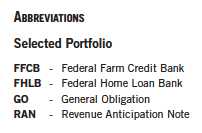
Semiannual Report | 33
Franklin Templeton Money Fund Trust
Shareholder Information
Franklin Templeton Money Fund
Proxy Voting Policies and Procedures
The Trust’s investment manager has established Proxy Voting Policies and Procedures (Policies) that the Trust uses to determine how to vote proxies relating to portfolio securities. Shareholders may view the Trust’s complete Policies online at franklintempleton.com. Alternatively, shareholders may request copies of the Policies free of charge by calling the Proxy Group collect at (954) 527-7678 or by sending a written request to: Franklin Templeton Companies, LLC, 300 S.E. 2nd Street, Fort Lauderdale, FL 33301, Attention: Proxy Group. Copies of the Trust’s proxy voting records are also made available online at franklintempleton.com and posted on the U.S. Securities and Exchange Commission’s website at sec.gov and reflect the most recent 12-month period ended June 30.
Quarterly Statement of Investments
The Trust files a complete statement of investments with the U.S. Securities and Exchange Commission for the first and third quarters for each fiscal year on Form N-Q. Shareholders may view the filed Form N-Q by visiting the Commission’s website at sec.gov. The filed form may also be viewed and copied at the Commission’s Public Reference Room in Washington, DC. Information regarding the operations of the Public Reference Room may be obtained by calling (800) SEC-0330.
34 | Semiannual Report
This page intentionally left blank.
This page intentionally left blank.
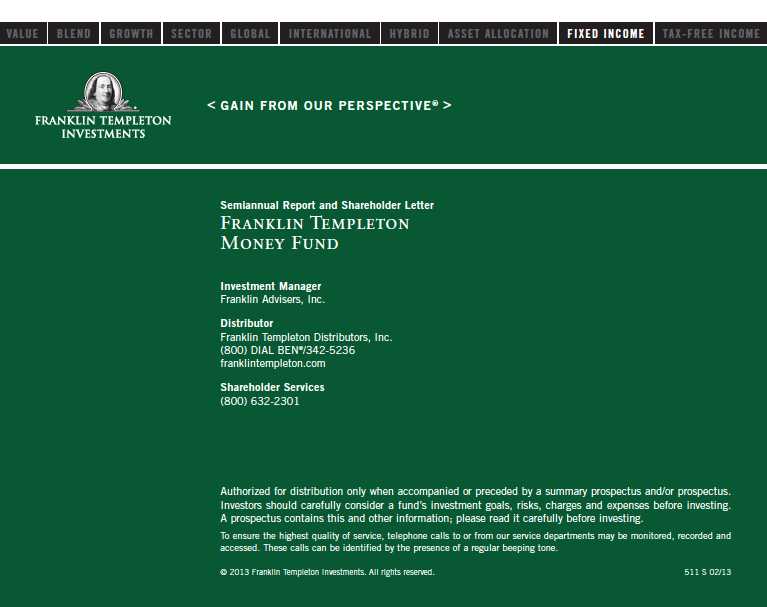
Item 2. Code of Ethics.
(a) The Registrant has adopted a code of ethics that applies to its principal executive officers and principal financial and accounting officer.
(c) N/A
(d) N/A
(f) Pursuant to Item 12(a)(1), the Registrant is attaching as an exhibit a copy of its code of ethics that applies to its principal executive officers and principal financial and accounting officer.
Item 3. Audit Committee Financial Expert.
(a)(1) The Registrant has an audit committee financial expert serving on its audit committee.
(2) The audit committee financial expert is John B. Wilson, and he is “independent” as defined under the relevant Securities and Exchange Commission Rules and Releases.
Item 4. Principal Accountant Fees and Services. N/A
Item 5. Audit Committee of Listed Registrants. N/A
Item 6. Schedule of Investments. N/A
Item 7. Disclosure of Proxy Voting Policies and Procedures for Closed-End Management Investment Companies. N/A
Item 8. Portfolio Managers of Closed-End Management Investment Companies. N/A
Item 9. Purchases of Equity Securities by Closed-End Management Investment Company and Affiliated Purchasers. N/A
Item 10. Submission of Matters to a Vote of Security Holders.
There have been no changes to the procedures by which shareholders may recommend nominees to the Registrant's Board of Trustees that would require disclosure herein.
Item 11. Controls and Procedures.
(a) Evaluation of Disclosure Controls and Procedures. The Registrant maintains disclosure controls and procedures that are designed to ensure that information required to be disclosed in the Registrant’s filings under the Securities Exchange Act of 1934 and the Investment
Company Act of 1940 is recorded, processed, summarized and reported within the periods specified in the rules and forms of the Securities and Exchange Commission. Such information is accumulated and communicated to the Registrant’s management, including its principal executive officer and principal financial officer, as appropriate, to allow timely decisions regarding required disclosure. The Registrant’s management, including the principal executive officer and the principal financial officer, recognizes that any set of controls and procedures, no matter how well designed and operated, can provide only reasonable assurance of achieving the desired control objectives.
Within 90 days prior to the filing date of this Shareholder Report on Form N-CSR, the Registrant had carried out an evaluation, under the supervision and with the participation of the Registrant’s management, including the Registrant’s principal executive officer and the Registrant’s principal financial officer, of the effectiveness of the design and operation of the Registrant’s disclosure controls and procedures. Based on such evaluation, the Registrant’s principal executive officer and principal financial officer concluded that the Registrant’s disclosure controls and procedures are effective.
(b) Changes in Internal Controls. There have been no changes in the Registrant’s internal controls or in other factors that could materially affect the internal controls over financial reporting subsequent to the date of their evaluation in connection with the preparation of this Shareholder Report on Form N-CSR.
Item 12. Exhibits.
(a)(1) Code of Ethics
(a)(2) Certifications pursuant to Section 302 of the Sarbanes-Oxley Act of 2002 of Laura F. Fergerson, Chief Executive Officer - Finance and Administration, and Gaston Gardey, Chief Financial Officer and Chief Accounting Officer
(b) Certifications pursuant to Section 906 of the Sarbanes-Oxley Act of 2002 of Laura F. Fergerson, Chief Executive Officer - Finance and Administration, and Gaston Gardey, Chief Financial Officer and Chief Accounting Officer
SIGNATURES
Pursuant to the requirements of the Securities Exchange Act of 1934 and the Investment Company Act of 1940, the registrant has duly caused this report to be signed on its behalf by the undersigned, thereunto duly authorized.
FRANKLIN TEMPLETON MONEY FUND TRUST
By /s/ Laura F. Fergerson
Laura F. Fergerson
Chief Executive Officer - Finance and Administration
Date February 27, 2013
Pursuant to the requirements of the Securities Exchange Act of 1934 and
the Investment Company Act of 1940, this report has been signed below
by the following persons on behalf of the registrant and in the
capacities and on the dates indicated.
By /s/ Laura F. Fergerson
Laura F. Fergerson
Chief Executive Officer - Finance and Administration
Date February 27, 2013
By /s/ Gaston Gardey
Gaston Gardey
Chief Financial Officer and Chief Accounting Officer
Date February 27, 2013